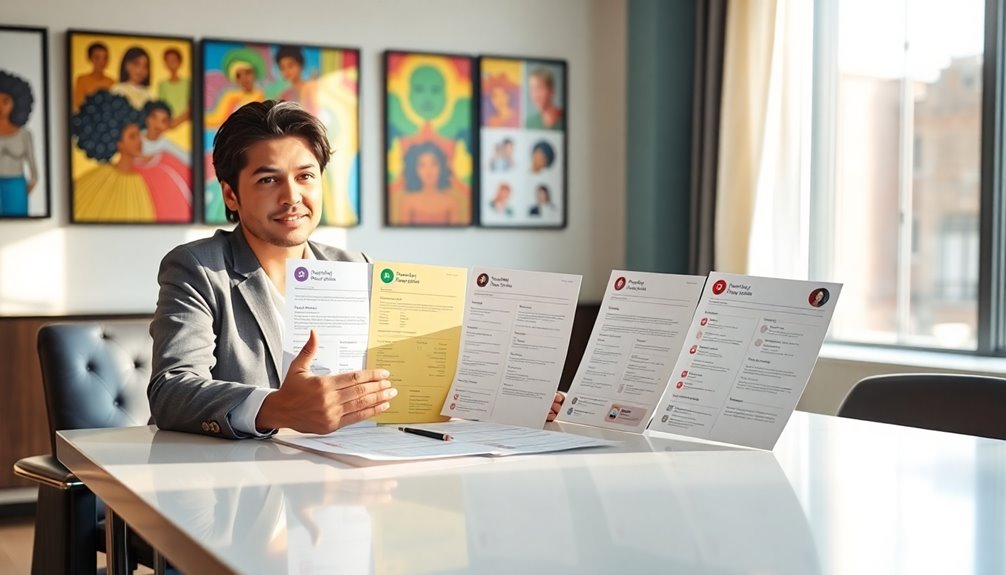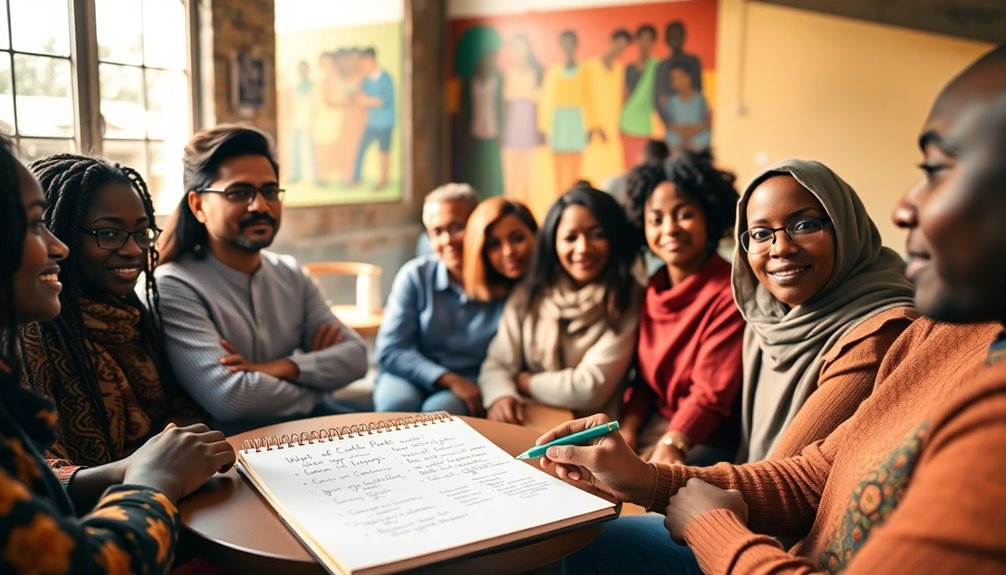Revealing diversity in hiring means asking the right questions during interviews. Start with "What does diversity mean to you?" to gauge personal values. Next, ask candidates to share experiences working with diverse teams, which reveals their adaptability. "How do you handle conflicts arising from cultural differences?" helps assess their conflict resolution skills. And don't forget about inclusivity strategies—questions like "What strategies would you implement to promote inclusivity?" can showcase their proactive thinking. These questions not only enhance team creativity and problem-solving but also align your workforce with a diverse customer base, leading to greater success overall. There's more to explore on this topic.
Key Takeaways
- Ask candidates, "What does diversity mean to you?" to understand their personal values and perspectives on inclusion.
- Inquire about experiences with diverse teams to assess adaptability and real-world application of inclusive practices.
- Pose questions about handling cultural conflicts to evaluate candidates' conflict resolution and communication skills.
- Explore strategies candidates would implement to promote inclusivity, reflecting their proactive thinking and commitment to diversity.
- Prepare candidates to share challenges faced in diverse environments, showcasing their resilience and contributions to fostering inclusion.
Importance of Diversity in Hiring

Diversity in hiring isn't just a buzzword; it's an essential strategy for fostering a dynamic workplace. When you prioritize diverse candidates, you're not just filling positions; you're actively enhancing creativity and innovation within your team.
A diverse workforce brings together various perspectives, allowing for improved problem-solving and decision-making. You also align your company with a broader customer base, ensuring your team reflects the communities you serve.
Additionally, embracing diversity boosts employee satisfaction, leading to higher retention rates. By creating an inclusive environment, you foster collaboration and open dialogue, ultimately driving your organization toward success. Furthermore, promoting continuous learning and skill development within your team helps maintain an adaptable and innovative workforce.
Key Diversity Interview Questions

Fostering a dynamic workplace begins with asking the right questions during interviews. Key diversity interview questions help you assess a candidate's values and experiences related to inclusion. Consider these essential questions:
| Question | Purpose |
|---|---|
| What does diversity mean to you? | Understand personal definitions and values. |
| Can you share an experience working with diverse teams? | Gauge real-life application of diversity concepts. |
| How do you handle conflicts arising from cultural differences? | Evaluate conflict resolution skills. |
| What strategies would you implement to promote inclusivity? | Assess proactive thinking about workplace dynamics. |
These questions not only reveal a candidate's commitment to diversity but also help you identify their potential to contribute to a more inclusive environment.
Strategies for Inclusive Hiring

When developing strategies for inclusive hiring, it's crucial to recognize how intentional practices can shape a more equitable recruitment process.
Start by implementing blind recruitment techniques to minimize bias, focusing solely on candidates' skills and experiences. Use diverse interview panels that reflect various backgrounds to promote inclusive perspectives during evaluations.
Advertise job openings in diverse communities and guarantee your job descriptions are free from jargon or exclusionary language. Encourage open dialogue about diversity, providing training on cultural competence for all staff members.
Celebrate diverse holidays and establish employee resource groups to foster a sense of belonging. Additionally, consider incorporating audience engagement strategies to ensure that all voices are heard during the hiring process.
These strategies not only enhance your hiring process but also contribute to a more inclusive workplace culture that values diversity at every level.
Leadership's Role in Diversity

Effective leadership is essential in driving diversity initiatives within an organization. You set the tone for an inclusive culture by demonstrating a strong commitment to diversity. Your actions influence team dynamics and encourage open conversations about differing perspectives.
When you establish clear diversity goals, you hold yourself and your team accountable for progress. It's vital to provide resources for diversity training, ensuring everyone understands the importance of inclusion.
Furthermore, by actively engaging in diverse hiring practices and celebrating various backgrounds, you foster an environment where everyone feels valued. Additionally, strong communication skills are crucial in facilitating discussions that allow all voices to be heard and respected.
Overcoming Resistance to Diversity

Although resistance to diversity can arise from various sources, addressing it head-on is essential for fostering an inclusive workplace. You might encounter colleagues who fear change or feel threatened by different perspectives.
Start by educating them on the tangible benefits of diversity—like enhanced creativity and improved problem-solving. Engage in open discussions, allowing everyone to voice their concerns and share success stories from diverse teams.
Use structured responses, like the STAR model, to address inappropriate behavior or biases directly. By creating an environment where people feel safe to express their thoughts, you can dismantle misconceptions and pave the way for acceptance.
Building Supportive Coworker Relationships

Fostering supportive relationships among coworkers is essential for creating a welcoming team environment. You can start by engaging in open conversations about personal experiences, which helps build trust and understanding.
Taking the time to learn about your colleagues' backgrounds not only reduces emotional labor but also promotes proactive learning. Establishing safe spaces for dialogue encourages everyone to share their thoughts and feelings, making it easier to address any concerns.
Recognizing and celebrating diversity within your team further strengthens these relationships. Remember, it's about creating a culture where everyone feels valued and included. Additionally, incorporating mindfulness techniques into team interactions can enhance present-moment awareness and reduce misunderstandings.
Communication Challenges in Diversity

Maneuvering communication challenges in diverse workplaces can be complex, as various cultural backgrounds often lead to misunderstandings and differing communication styles.
You might find that certain phrases or gestures have different meanings across cultures, causing confusion. Additionally, language barriers can hinder your ability to express ideas clearly or grasp others' points.
It's essential to practice active listening; this allows you to validate your coworkers' perspectives, fostering a more inclusive dialogue.
Adapt your communication style to accommodate different preferences, whether that means being more direct or using visual aids.
Finally, don't shy away from asking clarifying questions. By addressing these challenges head-on, you can enhance collaboration and create a more harmonious work environment for everyone involved.
Measuring Diversity Success

Measuring diversity success is essential for understanding the effectiveness of your inclusion initiatives and ensuring continuous improvement.
Start by tracking diversity metrics, like the representation of various demographics in your workforce. Use employee feedback and conduct regular assessments to gauge how well your initiatives resonate. Surveys can reveal employee sentiment and highlight areas needing attention.
Additionally, analyze retention rates among diverse employees; high turnover might indicate underlying issues. Adjust your strategies based on these insights, ensuring you're responsive to your workforce's needs.
Training for Inclusion

To create a truly inclusive workplace, ongoing training plays a vital role in reinforcing your diversity initiatives.
It's important to equip your team with the skills and understanding necessary to foster an environment where everyone feels valued. Tailoring your training programs to address specific challenges can enhance effectiveness and engagement.
Here are some key components to keep in mind:
- Incorporate real-world scenarios to make training relatable and practical.
- Encourage participation from all levels of the organization to promote accountability.
- Measure the effectiveness of training through regular feedback and assessments.
Preparing for Diversity Interviews

Preparing for diversity interviews can make a significant difference in how you present yourself as a candidate. Start by researching the company's values and commitment to diversity. Identify where your personal values align with theirs.
Anticipate common diversity-related questions, and prepare authentic responses based on your experiences in diverse environments. Seek mentorship or guidance on DEI topics to bolster your understanding.
Conduct mock interviews focused on diversity questions, allowing for constructive feedback. Stay informed about current events and trends related to diversity and inclusion, as this will enhance your conversations during the interview.
Finally, practice positive body language—maintain eye contact and exhibit confidence to establish a strong connection with your interviewers.
Frequently Asked Questions
How Can I Demonstrate My Commitment to Diversity During the Interview?
To demonstrate your commitment to diversity during the interview, share specific experiences where you worked in diverse teams or promoted inclusive practices.
Highlight your understanding of diversity's importance and how it fosters creativity and innovation.
Discuss strategies you've used to create a welcoming environment, and be ready to address challenges you've faced related to diversity.
Showing genuine passion and knowledge will leave a lasting impression on your interviewers.
What Are Some Common Misconceptions About Diversity in the Workplace?
When you think of diversity, imagine a vibrant tapestry, each thread representing unique experiences and perspectives.
A common misconception is that diversity solely means hiring people of different races or genders. It's more than that; it includes age, disability, and sexual orientation.
Another myth is that diversity leads to conflict, but it actually fosters creativity and innovation. Embracing diversity enhances collaboration, bringing out the best in everyone.
You'll discover strength in unity.
How Do Cultural Differences Affect Team Dynamics?
Cultural differences can greatly affect team dynamics. You might notice varied communication styles, decision-making processes, and conflict resolution approaches.
These differences can lead to misunderstandings but also foster creativity and innovation. Embracing diverse perspectives allows you to enhance problem-solving and collaboration.
To navigate these dynamics effectively, you'll want to cultivate open dialogue, encourage active listening, and promote respect for each team member's unique background, creating a more inclusive and productive work environment.
What Role Does Intersectionality Play in Diversity Discussions?
Imagine a tapestry woven from countless threads, each representing different identities and experiences.
Intersectionality plays a vital role in diversity discussions by recognizing how various aspects of identity—like race, gender, and class—interact and shape individual experiences.
It highlights that people face unique challenges based on their overlapping identities.
How Can I Continue Learning About Diversity After the Interview?
After your interview, you can continue learning about diversity by engaging with relevant books, articles, and podcasts.
Join workshops or webinars focused on diversity, equity, and inclusion topics.
Connect with diverse communities both online and offline to gain different perspectives.
Follow organizations that prioritize DEI efforts on social media to stay informed about current discussions.
Finally, consider finding a mentor who can guide you in understanding and promoting diversity in your personal and professional life.
Conclusion
Embracing diversity in the hiring process is like planting a vibrant garden—each unique perspective contributes to a richer, more colorful workplace. As you prepare for interviews, remember that asking the right questions can help you cultivate an inclusive environment where innovation flourishes. By prioritizing diversity and inclusion, you're not just filling positions; you're nurturing a culture that thrives on varied experiences and ideas. So, dig deep and watch your organization bloom into a powerhouse of creativity and collaboration.









